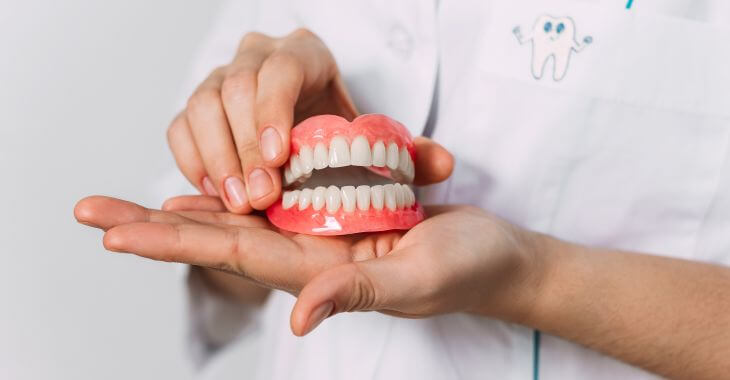What Are Dentures Made of Today?

Did you know that dentures have been used for centuries? While the dentures from hundreds of years ago differ greatly from those made today, they all offered a chance for wearers to chew food after losing their teeth. Dentures have advanced in both design and materials, but what are dentures made of today?
Brief History of Dentures
Most Americans heard the story of George Washington’s wooden dentures, but it was just that – a story. Dentures date back to 700 B.C., over 2,700 years ago, and even back then, dentures were made from bone or animal teeth. Ivory and teeth from humans and animals were the denture making materials used for many centuries – George Washington’s dentures in the 1700s were made from an ivory plate and teeth from humans or other animals. They also began creating teeth from porcelain, which is still one of the denture materials of today.
The modern form of dentures began in the mid-1800s. A rubber-like material replaced the ivory plate, creating a more flexible and comfortable plate to attach porcelain teeth. The denture design and material continued to change into the 20th century to make the more natural-appearing and comfortable options available today.
Denture Making Materials
Dentures come in a variety of styles and materials. What are dentures made of today? There are a few different options in materials and designs, depending on the aesthetics you desire and how much you want to spend. The following are the most common denture making materials used today.
- Porcelain
- For centuries, porcelain has been used for dentures and other restorative dentistry options. Porcelain has the natural appearance desired when replacing teeth – dental crowns, inlays, onlays and veneers are also made from porcelain. Porcelain is very durable and it is stain-resistant for a white, beautiful appearance.
- The benefit of porcelain dentures is that they can last for many years. They do not wear down as quickly as some of the other modern denture making materials, but the porcelain can be hard on the jaw. It is harder to find porcelain dentures in the U.S., compared to the plastic or acrylic varieties.
- Acrylic Resin or Plastic
- The most commonly used materials for making dentures are forms of plastic. Acrylic resin and plastic bases are lightweight and resin teeth are easier to adjust in size and shape than porcelain. Acrylic dentures are cost-effective to make and cost less than porcelain dentures, but there are drawbacks.
- Compared to porcelain dentures, acrylic dentures tend to wear down much faster. While porcelain dentures can last for well over a decade, most plastic dentures will need to be replaced after around 5-8 years. This is due to the artificial teeth wearing down, creating a misalignment when biting.
- Metal
- While dentures are not completely made from metal, many do contain some metal. Partial dentures use metal cages that attach to the existing teeth to hold the partial denture in place. Some complete dentures may also have metal in the design.
Types of Denture Options
If you have lost a few or all your teeth, dentures are the most cost-effective option for smile restoration. The traditional denture is removable and held in place by either adhesive, suction or existing teeth. Partial and complete conventional dentures are removed each night and soaked to keep them clean.
Fixed dentures, both partial and complete, are another option. For those who do not prefer dentures that can be removed, there are options for fixed-in-place dentures. These include some of the following options:
- Fixed dental bridge/partial. Dental bridges are a fixed partial denture that are attached to surrounding teeth with the help of dental crowns. This is an option to replace a few missing teeth.
- Snap-on dentures. A type of implant-assisted denture, snap-on dentures click and lock in place. There are different designs; some can be removed by the patient, while others are screwed into place by the dentist.
- Implant-supported dentures. Several dental implants are used to support overdentures, which can provide a fixed set of teeth.
- Hybrid dentures with implants. The most recent options in implant-supported dentures use hybrid dentures without an upper palate. This allows for a more natural feel and appearance, usually requiring 4-6 implants per arch – All-on-4 or All-on-6 dental implants.
Most of the fixed denture options are made from plastic denture making materials. These are lightweight and can be supported by existing teeth or dental implants. There are also zirconia restorations like dental crowns and bridges that are often created in-office for same-day restorations.

If you are considering dentures, there are many different materials and types from which to choose. From partial and complete traditional dentures to hybrid dental implants, you have many options. To learn more about denture-making materials and which type will fit your budget, contact your local restorative dentist.
The information provided on this website, including text, graphics, images, and other materials, is intended solely for informational purposes and should not be used as a substitute for professional medical advice, diagnosis, or treatment.



)